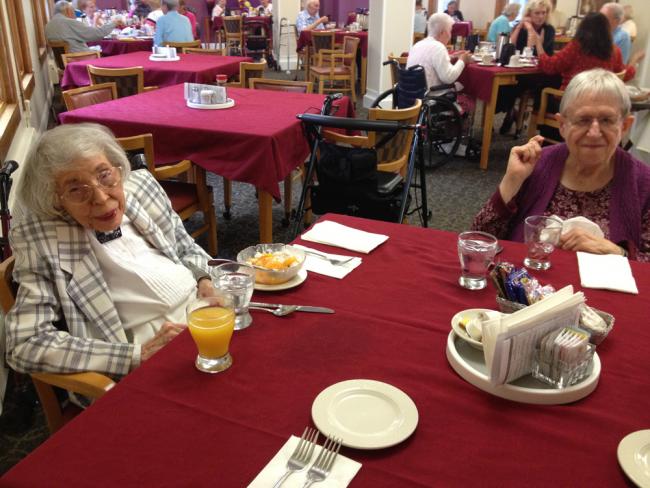Residents say the food is fine at retirement homes
Edna Scott (left) enjoys a fruit and yogurt salad from the salad bar. “I don’t think we’ll ever get rid of the salad bar,” Alex Flores, acting director of dining, said, laughing.
Wed, 09/25/2013
By Simone Alicea
My mother often tells me that if I ever put her in a nursing home, her ghost will haunt me for the rest of my days. It was this threat I had in mind when my editor asked me to write a piece on food in retirement homes.
However, I was surprised to find that food preparation and service in retirement facilities is highly regulated and often high-quality.
“I was amazed at what I received,” said Paula Mezger, 64. Mezger, a former nurse, has been a resident at Burien Nursing and Rehabilitation since May, and says she likes that the food is well seasoned and that they serve decent coffee.
“They try hard not to give me stuff I don’t like,” Mezger said. “It was very unexpected.”
Long-term care facilities and their kitchens come in all shapes and sizes. The largest of these are what are known as Continuing Care Retirement Communities. CCRCs offer seniors a range of living options from independent living apartments to full-time skilled nursing. Other facilities, such as Burien Nursing and Rehabilitation, may focus on one or more of these options.
In the city of Des Moines, nearly 15 percent of the population is over the age of 65 according to the 2010 census. Des Moines is also home to two major CCRCs, Judson Park and Wesley Homes. The campuses for both of these communities are expansive: They’re like entire small neighborhoods, created especially for this one part of the population.
“[Residents] want a lot of choices and want to live well,” said Karen Werner, dining services director at Judson Park. “They don’t want to just sit in a rocking chair.”
Judson Park spans just about three blocks on Marine View Drive, where it faces the Pudget Sound. Walking into the lobby feels more like walking into a hotel than a nursing home. As you walk through the parking lot, you can see a gym and small salon through the windows.
When it comes to dining, each community does it a little differently. Some places use trays and a buffet line; others have a menu with restaurant-style service.
Joanne Marr, a resident at Wesley homes, lives in one of the independent cottages, and mostly cooks her own meals. However, she likes to come to the dining hall for special occasions.
“We come to three to four meals a year to honor the employees,” Marr said. “There are no strangers here.”
Choice and communication
When people think of nursing home food, they typically think of tasteless gunk on metal trays served by stern-looking nurses. However, according to these culinary directors, that sit-down-shut-up-and-eat attitude is largely a thing of the past.
“When I first got started, kitchens served one entree and that was it,” said Amy Stewart, director of dietary management at Burien Nursing and Rehabilitation. “Hopefully you had a cook who made something else. Here we are today where some facilities are completely like a restaurant.”
Administrator Lynda Baldwin added, “You can’t shortchange on food.”
Founded in 1901, The Kenney is the oldest continuing care community in Seattle. The West Seattle facility has been in transition as it seeks new sponsorship. On the dining end, Interim Dining Services Director Alex Flores says that part of that transition will probably be to a restaurant-style service with more made-to-order options.
“We’re going through some exciting times,” Flores said. “Seniors looking to move in are looking for a more restaurant style. [Residents] have different desires and wants.”
When it comes to things like diabetes, low-sugar, or low-salt diets, nursing home kitchens would traditionally just prohibit residents from eating those things. Now, however, it’s more common to explain the repercussions of certain diet choices, while ultimately allowing residents to choose what they do and do not eat.
“We’re not imposing diets. We’re not going to institutionalize feeding,” Werner said. “A lot of times [residents] will self-restrict. I’ve found the more restrictions you put on somebody, the more they find a way around it.”
When I talked to residents, the general consensus was that the food was pretty good. Kenney resident Larry Puffert, 86, said that he especially liked the ribs.
“The staff is friendly as all get out,” Puffert said. “It’s delightful.”
Puffert told a story about a German couple who wanted to have wine with their meals. When he moved in six years ago, Puffert had never seen a couple bring wine to the dining room. He said the administrators put it to the community to vote, and that the residents overwhelmingly voted yes.
“The staff doesn’t serve the wine,” Puffert said, “but they started providing wine glasses.”
As expected, there are some complaints about the food: Some say there isn’t enough variety or that it’s too cold.
I watched an exchange between Stewart and long-time resident Marilyn Rodrigues, 54. Rodrigues complained that there wasn’t enough variety in the food, and Stewart asked what she would like to see. This kind of relationship seems to be the rule rather than the exception: Residents know their staff and feel comfortable asking for what they want.
“We talk about the food, and what we don’t like,” Rodgrigues said. “I know all the cooks, and they understand me.”






